TOYOTA PRIUS PRIME 2023 Owners Manual
Manufacturer: TOYOTA, Model Year: 2023, Model line: PRIUS PRIME, Model: TOYOTA PRIUS PRIME 2023Pages: 680, PDF Size: 14.97 MB
Page 291 of 680
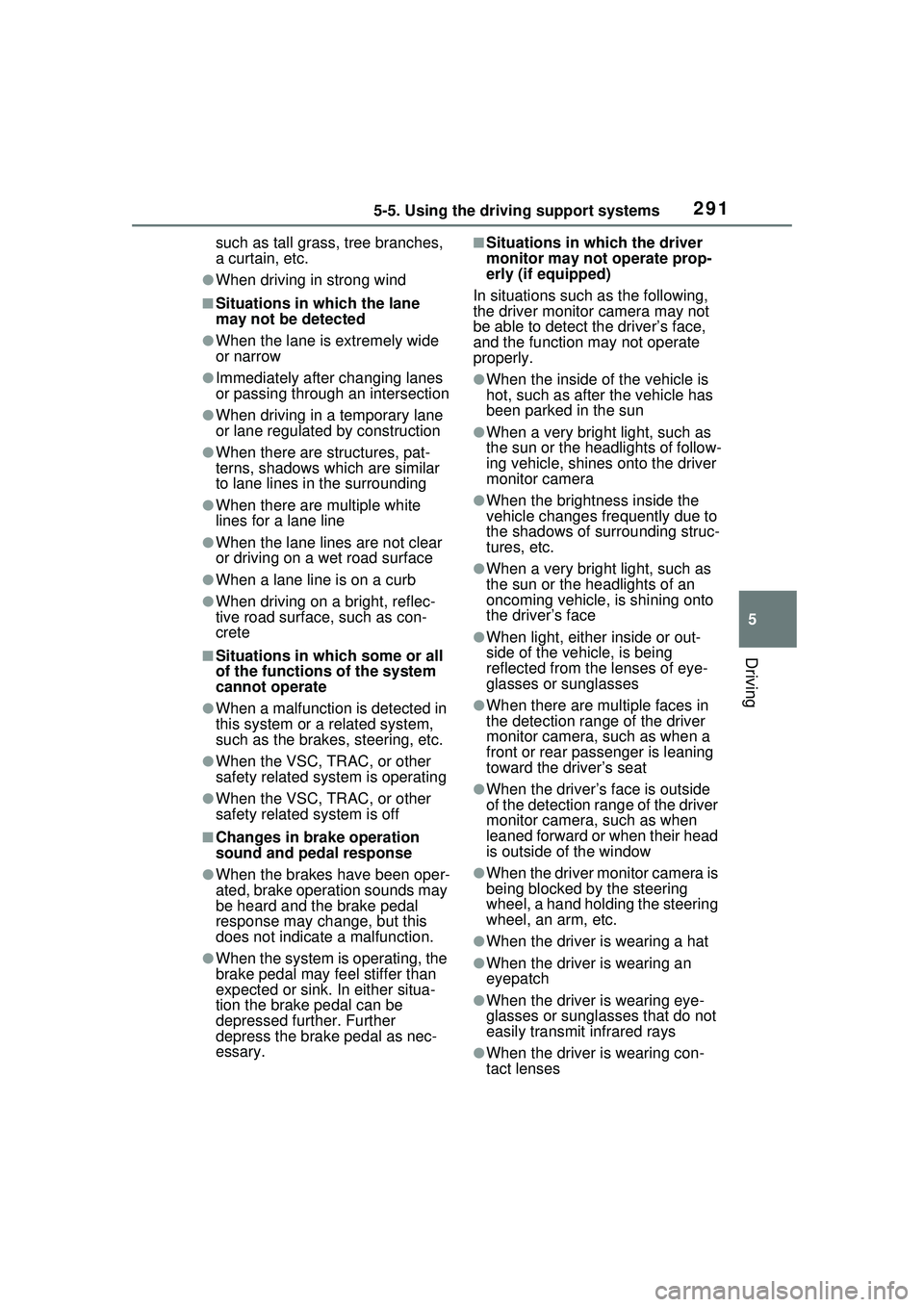
2915-5. Using the driving support systems
5
Driving
such as tall grass, tree branches,
a curtain, etc.
●When driving in strong wind
■Situations in which the lane
may not be detected
●When the lane is extremely wide
or narrow
●Immediately after changing lanes
or passing through an intersection
●When driving in a temporary lane
or lane regulated by construction
●When there are structures, pat-
terns, shadows which are similar
to lane lines in the surrounding
●When there are multiple white
lines for a lane line
●When the lane lines are not clear
or driving on a wet road surface
●When a lane line is on a curb
●When driving on a bright, reflec-
tive road surface, such as con-
crete
■Situations in which some or all
of the functions of the system
cannot operate
●When a malfunction is detected in
this system or a related system,
such as the brakes, steering, etc.
●When the VSC, TRAC, or other
safety related syst em is operating
●When the VSC, TRAC, or other
safety related system is off
■Changes in brake operation
sound and pedal response
●When the brakes have been oper-
ated, brake operation sounds may
be heard and the brake pedal
response may change, but this
does not indicate a malfunction.
●When the system is operating, the
brake pedal may feel stiffer than
expected or sink. In either situa-
tion the brake pedal can be
depressed further. Further
depress the brake pedal as nec-
essary.
■Situations in which the driver
monitor may not operate prop-
erly (if equipped)
In situations such as the following,
the driver monitor camera may not
be able to detect the driver’s face,
and the function may not operate
properly.
●When the inside of the vehicle is
hot, such as after the vehicle has
been parked in the sun
●When a very bright light, such as
the sun or the headlights of follow-
ing vehicle, shines onto the driver
monitor camera
●When the brightness inside the
vehicle changes frequently due to
the shadows of surrounding struc-
tures, etc.
●When a very bright light, such as
the sun or the headlights of an
oncoming vehicle, is shining onto
the driver’s face
●When light, either inside or out-
side of the vehicle, is being
reflected from the lenses of eye-
glasses or sunglasses
●When there are multiple faces in
the detection range of the driver
monitor camera, such as when a
front or rear passenger is leaning
toward the driver’s seat
●When the driver’s face is outside
of the detection range of the driver
monitor camera, such as when
leaned forward or when their head
is outside of the window
●When the driver monitor camera is
being blocked by the steering
wheel, a hand holding the steering
wheel, an arm, etc.
●When the driver is wearing a hat
●When the driver is wearing an
eyepatch
●When the driver is wearing eye-
glasses or sunglasses that do not
easily transmit infrared rays
●When the driver is wearing con-
tact lenses
Page 292 of 680
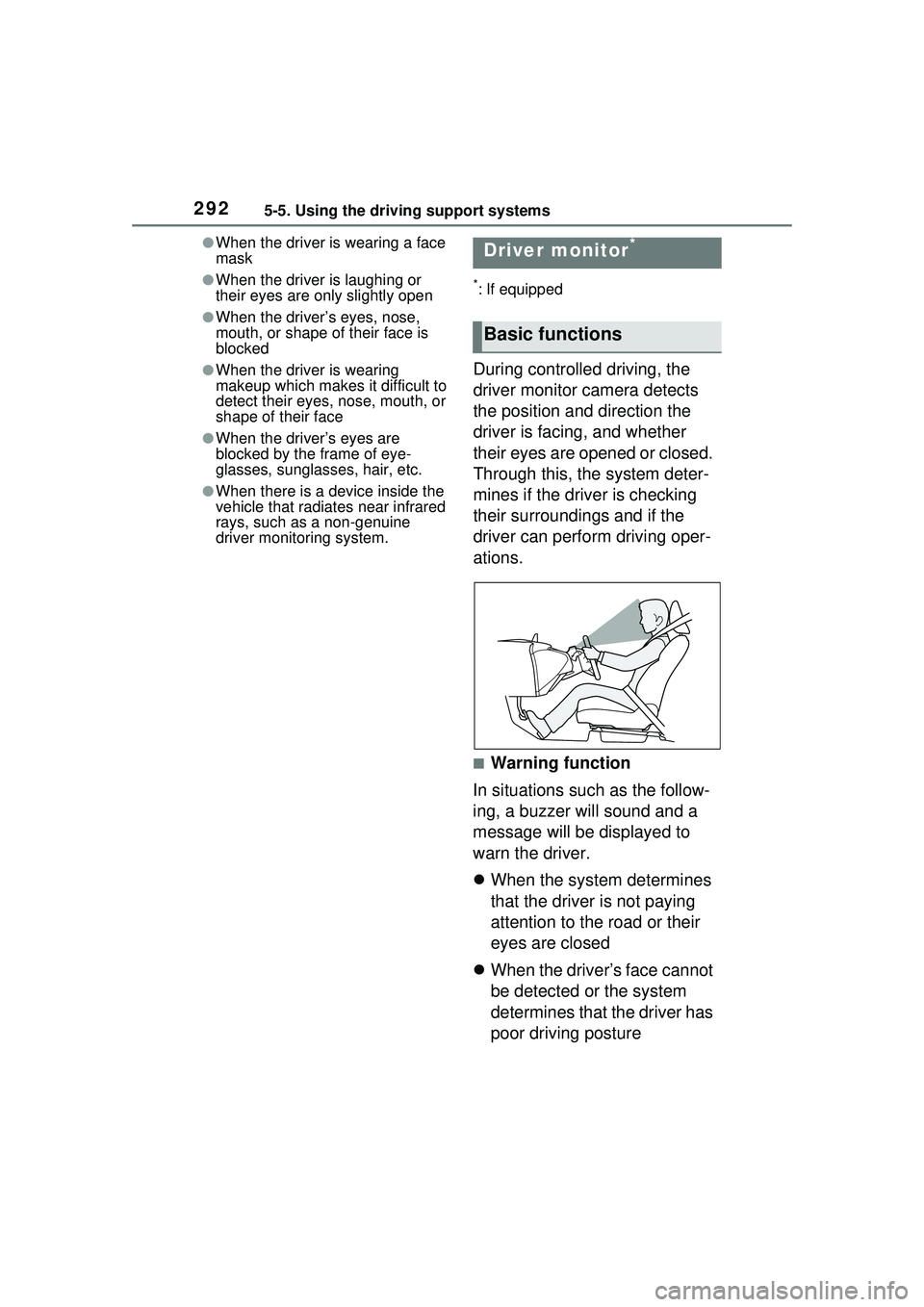
2925-5. Using the driving support systems
●When the driver is wearing a face
mask
●When the driver is laughing or
their eyes are only slightly open
●When the driver’s eyes, nose,
mouth, or shape of their face is
blocked
●When the driver is wearing
makeup which makes it difficult to
detect their eyes, nose, mouth, or
shape of their face
●When the driver’s eyes are
blocked by the frame of eye-
glasses, sunglasses, hair, etc.
●When there is a device inside the
vehicle that radiates near infrared
rays, such as a non-genuine
driver monitoring system.
*: If equipped
During controlled driving, the
driver monitor camera detects
the position and direction the
driver is facing, and whether
their eyes are opened or closed.
Through this, the system deter-
mines if the driver is checking
their surroundings and if the
driver can perform driving oper-
ations.
■Warning function
In situations such as the follow-
ing, a buzzer will sound and a
message will be displayed to
warn the driver.
When the system determines
that the driver is not paying
attention to the road or their
eyes are closed
When the driver’s face cannot
be detected or the system
determines that the driver has
poor driving posture
Driver monitor*
Basic functions
Page 293 of 680
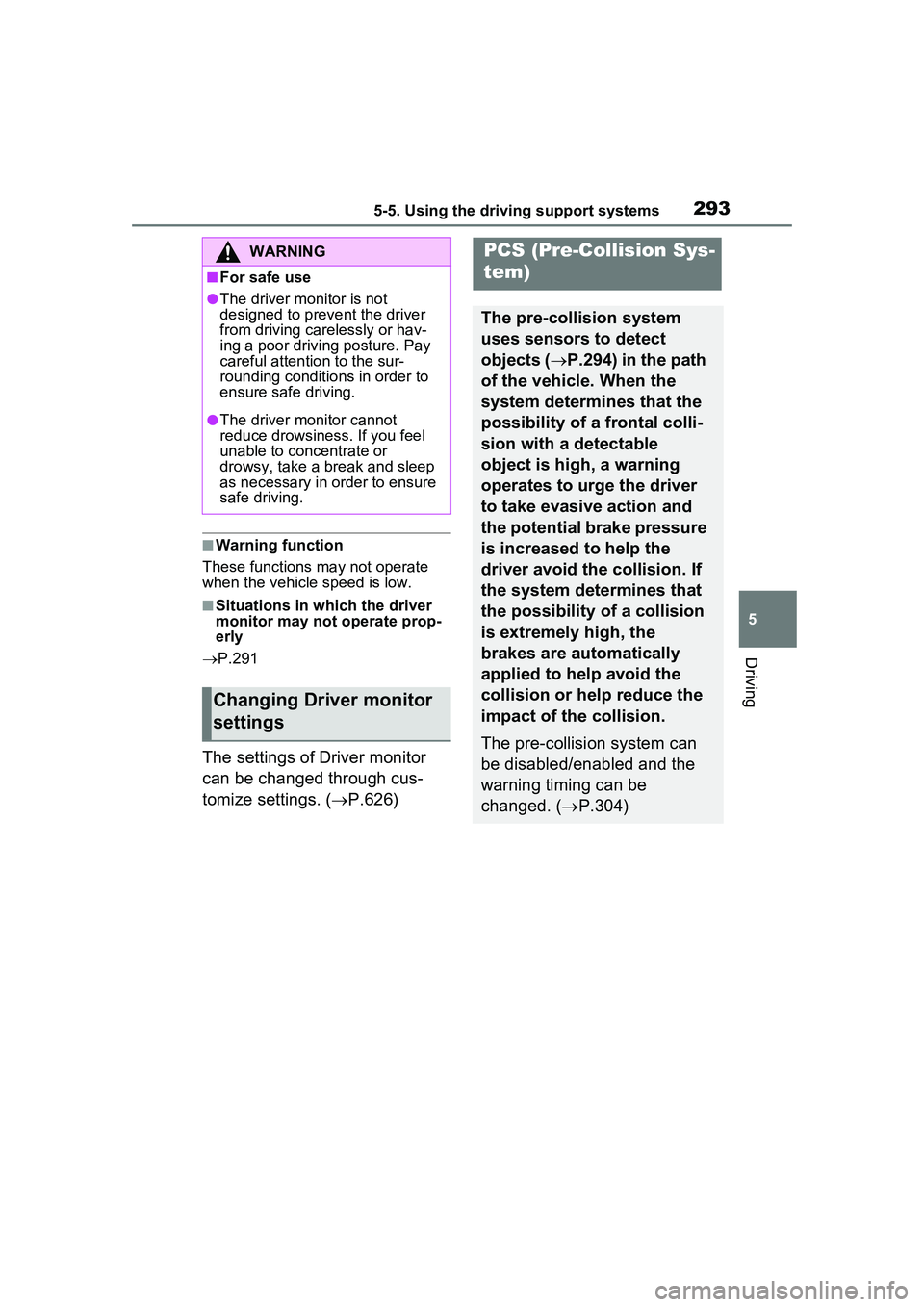
2935-5. Using the driving support systems
5
Driving
■Warning function
These functions may not operate
when the vehicle speed is low.
■Situations in which the driver
monitor may not operate prop-
erly
P.291
The settings of Driver monitor
can be changed through cus-
tomize settings. ( P.626)
WARNING
■For safe use
●The driver monitor is not
designed to prevent the driver
from driving carelessly or hav-
ing a poor driving posture. Pay
careful attention to the sur-
rounding conditions in order to
ensure safe driving.
●The driver monitor cannot
reduce drowsiness. If you feel
unable to concentrate or
drowsy, take a break and sleep
as necessary in order to ensure
safe driving.
Changing Driver monitor
settings
PCS (Pre-Collision Sys-
tem)
The pre-collision system
uses sensors to detect
objects ( P.294) in the path
of the vehicle. When the
system determines that the
possibility of a frontal colli-
sion with a detectable
object is high, a warning
operates to urge the driver
to take evasive action and
the potential brake pressure
is increased to help the
driver avoid the collision. If
the system determines that
the possibility of a collision
is extremely high, the
brakes are automatically
applied to help avoid the
collision or help reduce the
impact of the collision.
The pre-collision system can
be disabled/enabled and the
warning timing can be
changed. ( P.304)
Page 294 of 680
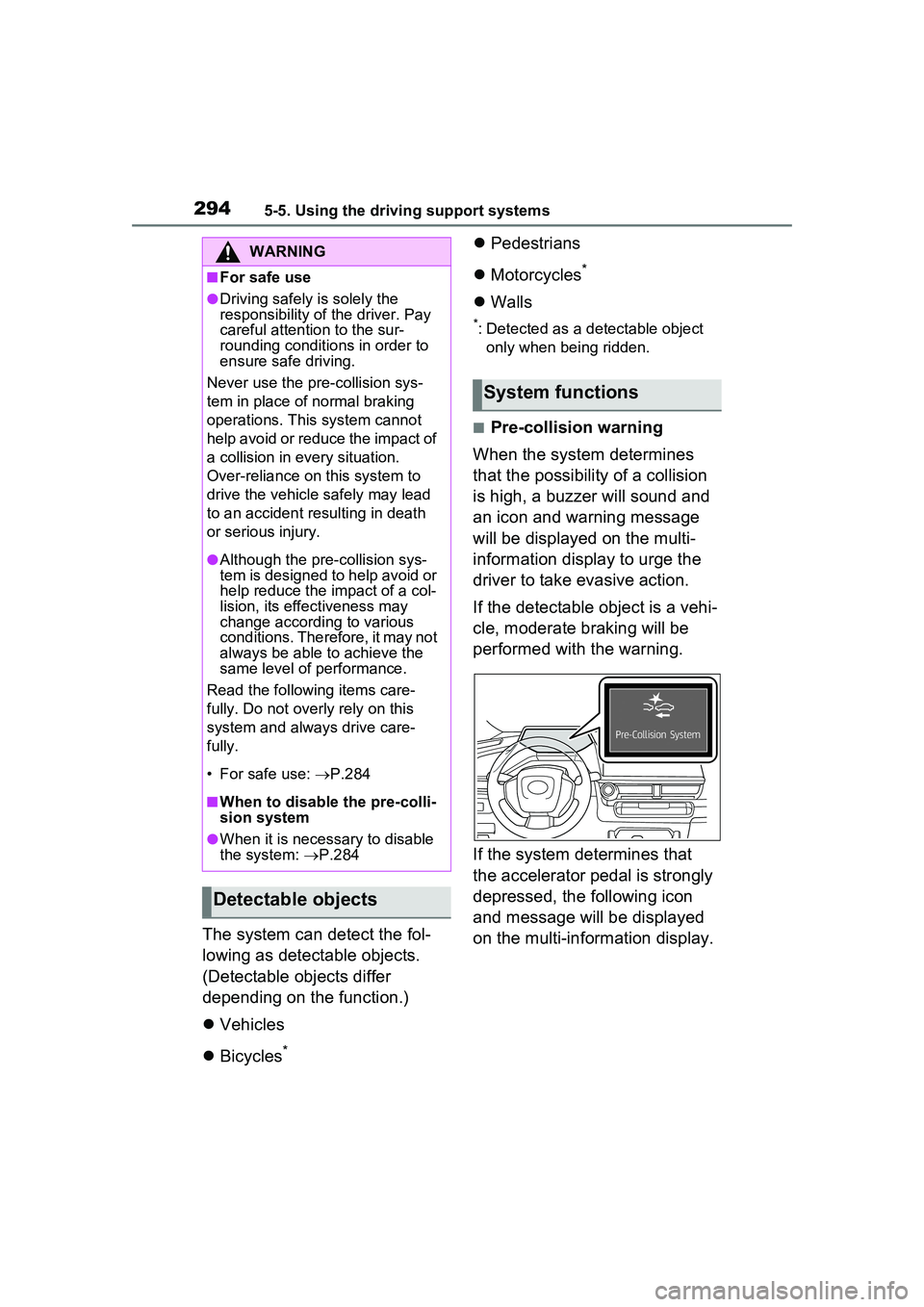
2945-5. Using the driving support systems
The system can detect the fol-
lowing as detectable objects.
(Detectable objects differ
depending on the function.)
Vehicles
Bicycles
*
Pedestrians
Motorcycles
*
Walls
*: Detected as a detectable object
only when being ridden.
■Pre-collision warning
When the system determines
that the possibility of a collision
is high, a buzzer will sound and
an icon and warning message
will be displayed on the multi-
information display to urge the
driver to take evasive action.
If the detectable object is a vehi-
cle, moderate braking will be
performed with the warning.
If the system determines that
the accelerator pedal is strongly
depressed, the following icon
and message will be displayed
on the multi-information display.
WARNING
■For safe use
●Driving safely is solely the
responsibility of the driver. Pay
careful attention to the sur-
rounding conditions in order to
ensure safe driving.
Never use the pre-collision sys-
tem in place of normal braking
operations. This system cannot
help avoid or reduce the impact of
a collision in every situation.
Over-reliance on this system to
drive the vehicle safely may lead
to an accident resulting in death
or serious injury.
●Although the pre-collision sys-
tem is designed to help avoid or
help reduce the impact of a col-
lision, its effectiveness may
change according to various
conditions. Therefore, it may not
always be able to achieve the
same level of performance.
Read the following items care-
fully. Do not overly rely on this
system and always drive care-
fully.
• For safe use: P.284
■When to disable the pre-colli-
sion system
●When it is necessary to disable
the system: P.284
Detectable objects
System functions
Page 295 of 680
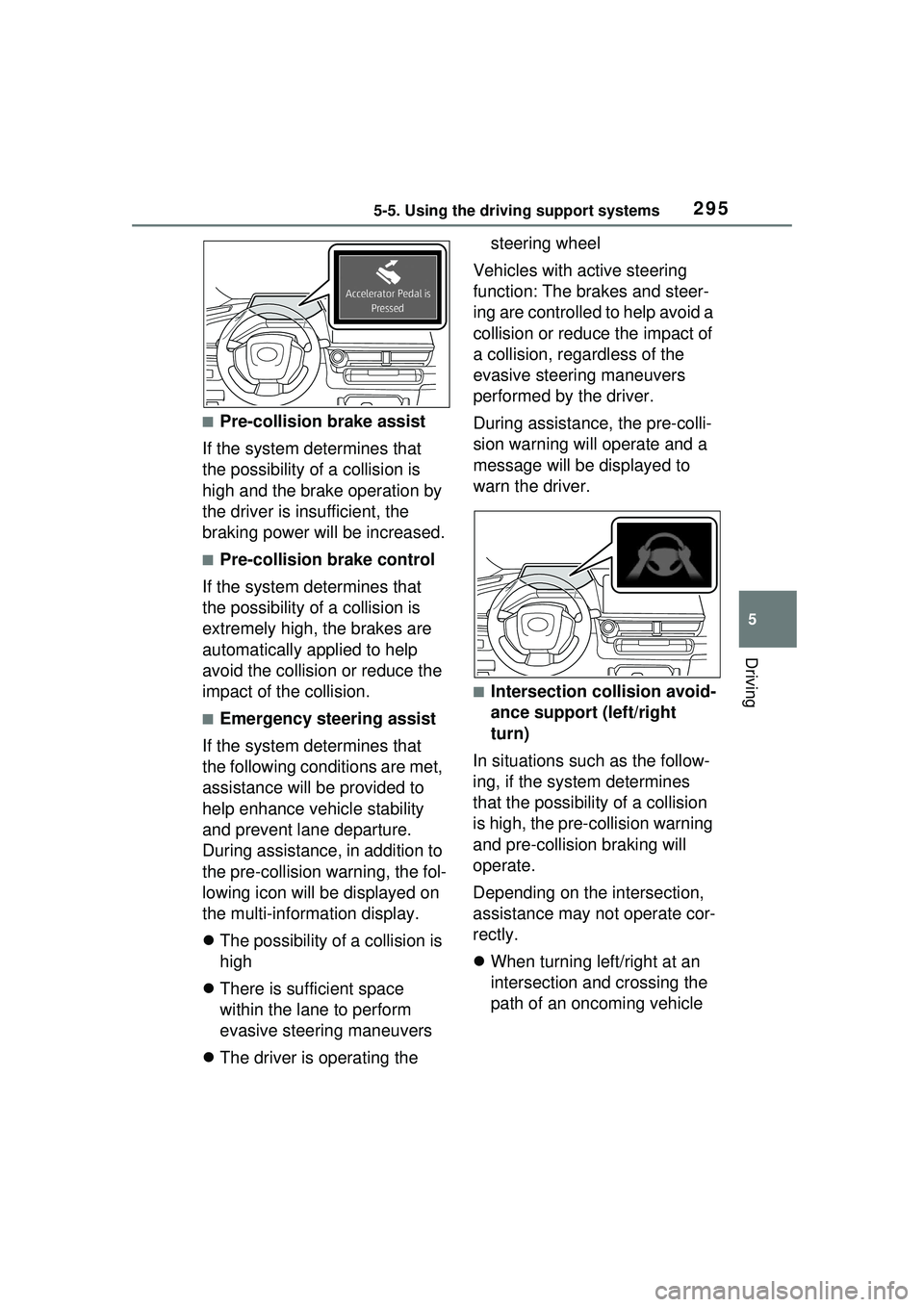
2955-5. Using the driving support systems
5
Driving
■Pre-collision brake assist
If the system determines that
the possibility of a collision is
high and the brake operation by
the driver is insufficient, the
braking power will be increased.
■Pre-collision brake control
If the system determines that
the possibility of a collision is
extremely high, the brakes are
automatically applied to help
avoid the collision or reduce the
impact of the collision.
■Emergency steering assist
If the system determines that
the following conditions are met,
assistance will be provided to
help enhance vehicle stability
and prevent lane departure.
During assistance, in addition to
the pre-collision warning, the fol-
lowing icon will be displayed on
the multi-information display.
The possibility of a collision is
high
There is sufficient space
within the lane to perform
evasive steering maneuvers
The driver is operating the steering wheel
Vehicles with active steering
function: The brakes and steer-
ing are controlled to help avoid a
collision or reduce the impact of
a collision, regardless of the
evasive steering maneuvers
performed by the driver.
During assistance, the pre-colli-
sion warning will operate and a
message will be displayed to
warn the driver.
■Intersection collision avoid-
ance support (left/right
turn)
In situations such as the follow-
ing, if the system determines
that the possibility of a collision
is high, the pre-collision warning
and pre-collision braking will
operate.
Depending on the intersection,
assistance may not operate cor-
rectly.
When turning left/right at an
intersection and crossing the
path of an oncoming vehicle
Page 296 of 680
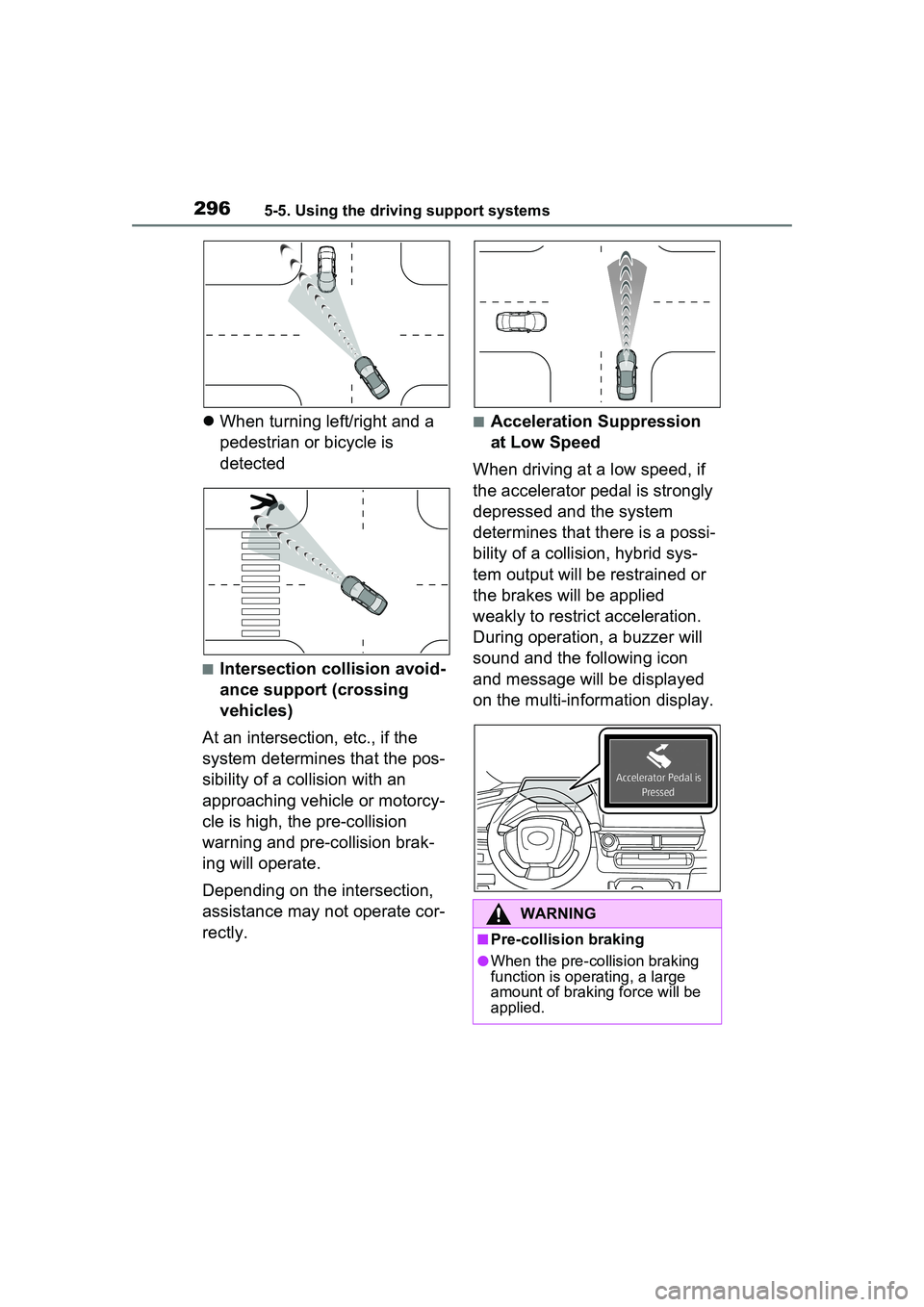
2965-5. Using the driving support systems
When turning left/right and a
pedestrian or bicycle is
detected
■Intersection collision avoid-
ance support (crossing
vehicles)
At an intersection, etc., if the
system determines that the pos-
sibility of a collision with an
approaching vehicle or motorcy-
cle is high, the pre-collision
warning and pre-collision brak-
ing will operate.
Depending on the intersection,
assistance may not operate cor-
rectly.
■Acceleration Suppression
at Low Speed
When driving at a low speed, if
the accelerator pedal is strongly
depressed and the system
determines that there is a possi-
bility of a collision, hybrid sys-
tem output will be restrained or
the brakes will be applied
weakly to restrict acceleration.
During operation, a buzzer will
sound and the following icon
and message will be displayed
on the multi-information display.
WARNING
■Pre-collision braking
●When the pre-co llision braking
function is operating, a large
amount of braking force will be
applied.
Page 297 of 680
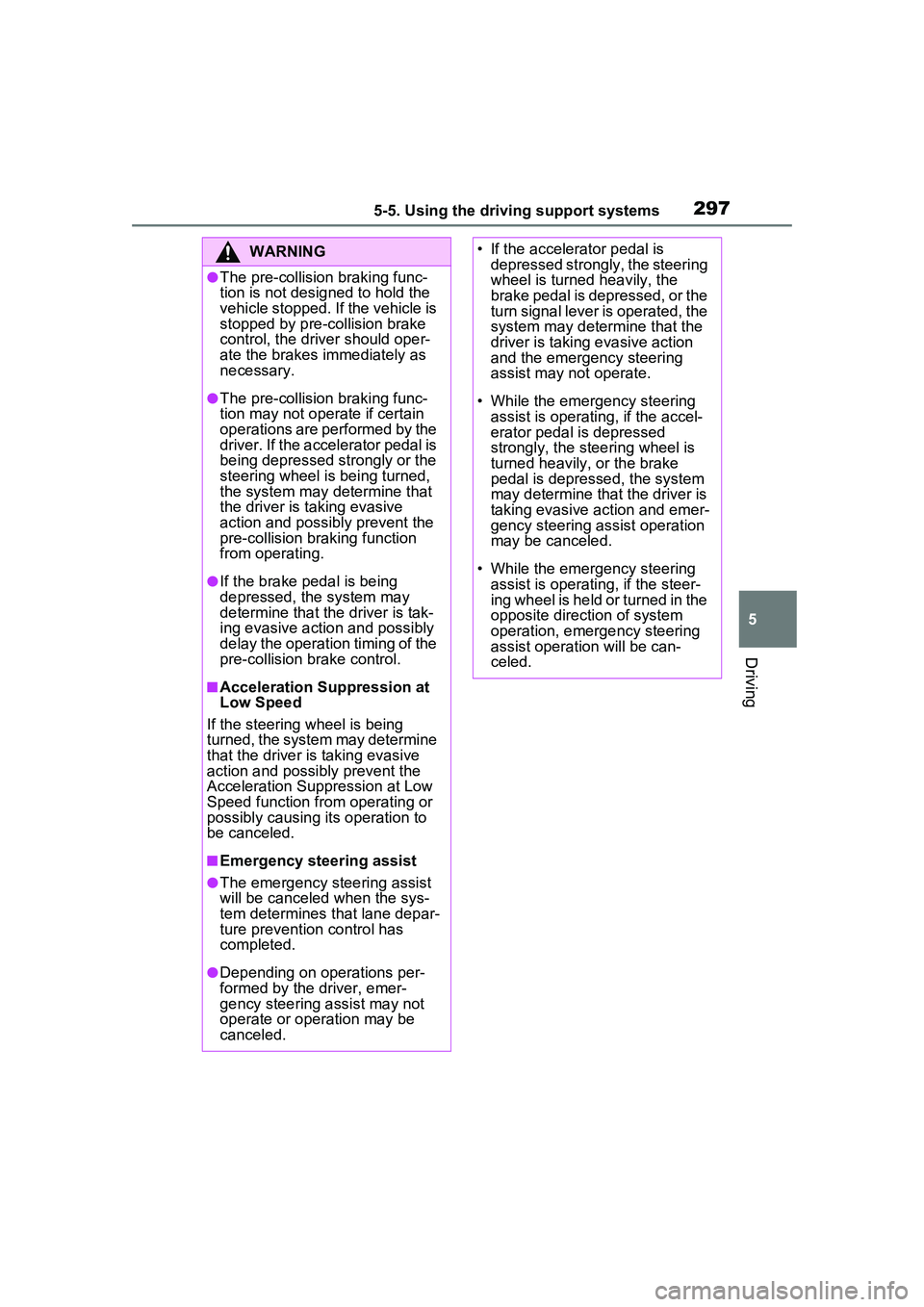
2975-5. Using the driving support systems
5
Driving
WARNING
●The pre-collision braking func-
tion is not designed to hold the
vehicle stopped. If the vehicle is
stopped by pre-collision brake
control, the driver should oper-
ate the brakes immediately as
necessary.
●The pre-collision braking func-
tion may not operate if certain
operations are performed by the
driver. If the accelerator pedal is
being depressed strongly or the
steering wheel is being turned,
the system may determine that
the driver is taking evasive
action and possibly prevent the
pre-collision braking function
from operating.
●If the brake pedal is being
depressed, the system may
determine that the driver is tak-
ing evasive action and possibly
delay the operation timing of the
pre-collision brake control.
■Acceleration Suppression at
Low Speed
If the steering wheel is being
turned, the syste m may determine
that the driver is taking evasive
action and possibly prevent the
Acceleration Suppression at Low
Speed function from operating or
possibly causing its operation to
be canceled.
■Emergency steering assist
●The emergency steering assist
will be canceled when the sys-
tem determines that lane depar-
ture prevention control has
completed.
●Depending on operations per-
formed by the driver, emer-
gency steering assist may not
operate or operation may be
canceled.
• If the accelerator pedal is depressed strongly, the steering
wheel is turned heavily, the
brake pedal is depressed, or the
turn signal lever is operated, the
system may determine that the
driver is taking evasive action
and the emergency steering
assist may not operate.
• While the emergency steering assist is operating, if the accel-
erator pedal is depressed
strongly, the steering wheel is
turned heavily, or the brake
pedal is depressed, the system
may determine that the driver is
taking evasive action and emer-
gency steering assist operation
may be canceled.
• While the emergency steering assist is operating, if the steer-
ing wheel is held or turned in the
opposite direction of system
operation, emergency steering
assist operation will be can-
celed.
Page 298 of 680
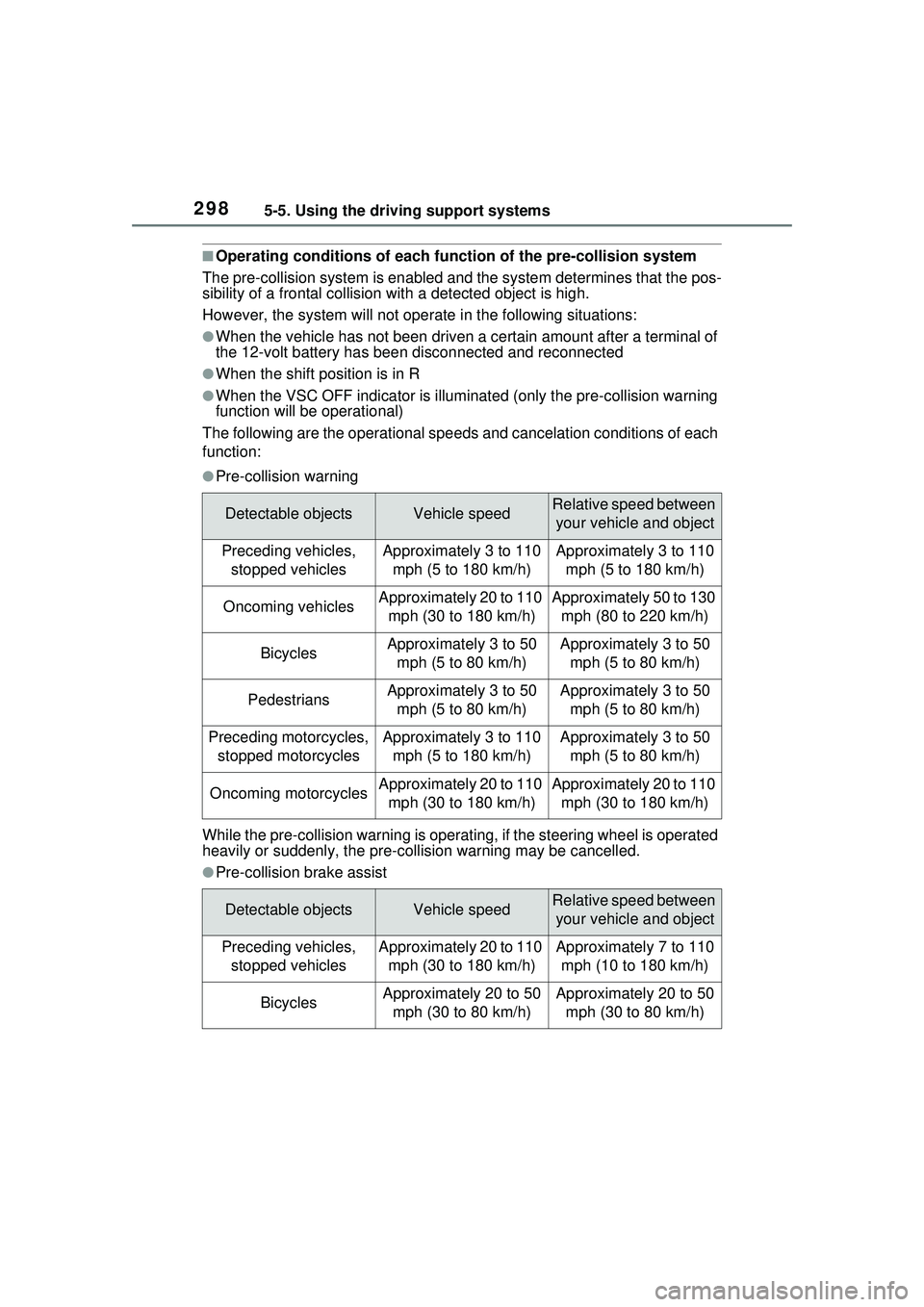
2985-5. Using the driving support systems
■Operating conditions of each function of the pre-collision system
The pre-collision syst em is enabled and the syste m determines that the pos-
sibility of a frontal collision with a detected object is high.
However, the system will not opera te in the following situations:
●When the vehicle has not been driven a certain amount after a terminal of
the 12-volt battery has been disconnected and reconnected
●When the shift position is in R
●When the VSC OFF indica tor is illuminated (only the pre-collision warning
function will be operational)
The following are the operational speeds and cancelation conditions of each
function:
●Pre-collision warning
While the pre-collision warning is operat ing, if the steering wheel is operated
heavily or suddenly, the pre-collision warning may be cancelled.
●Pre-collision brake assist
Detectable objectsVehicle speedRelative speed between
your vehicle and object
Preceding vehicles, stopped vehiclesApproximately 3 to 110 mph (5 to 180 km/h)Approximately 3 to 110 mph (5 to 180 km/h)
Oncoming vehiclesApproximately 20 to 110 mph (30 to 180 km/h)Approximately 50 to 130 mph (80 to 220 km/h)
BicyclesApproximately 3 to 50 mph (5 to 80 km/h)Approximately 3 to 50 mph (5 to 80 km/h)
PedestriansApproximately 3 to 50 mph (5 to 80 km/h)Approximately 3 to 50 mph (5 to 80 km/h)
Preceding motorcycles, stopped motorcyclesApproximately 3 to 110 mph (5 to 180 km/h)Approximately 3 to 50 mph (5 to 80 km/h)
Oncoming motorcyclesApproximately 20 to 110 mph (30 to 180 km/h)Approximately 20 to 110 mph (30 to 180 km/h)
Detectable objectsVehicle speedRelative speed between your vehicle and object
Preceding vehicles, stopped vehiclesApproximately 20 to 110 mph (30 to 180 km/h)Approximately 7 to 110 mph (10 to 180 km/h)
BicyclesApproximately 20 to 50 mph (30 to 80 km/h)Approximately 20 to 50 mph (30 to 80 km/h)
Page 299 of 680
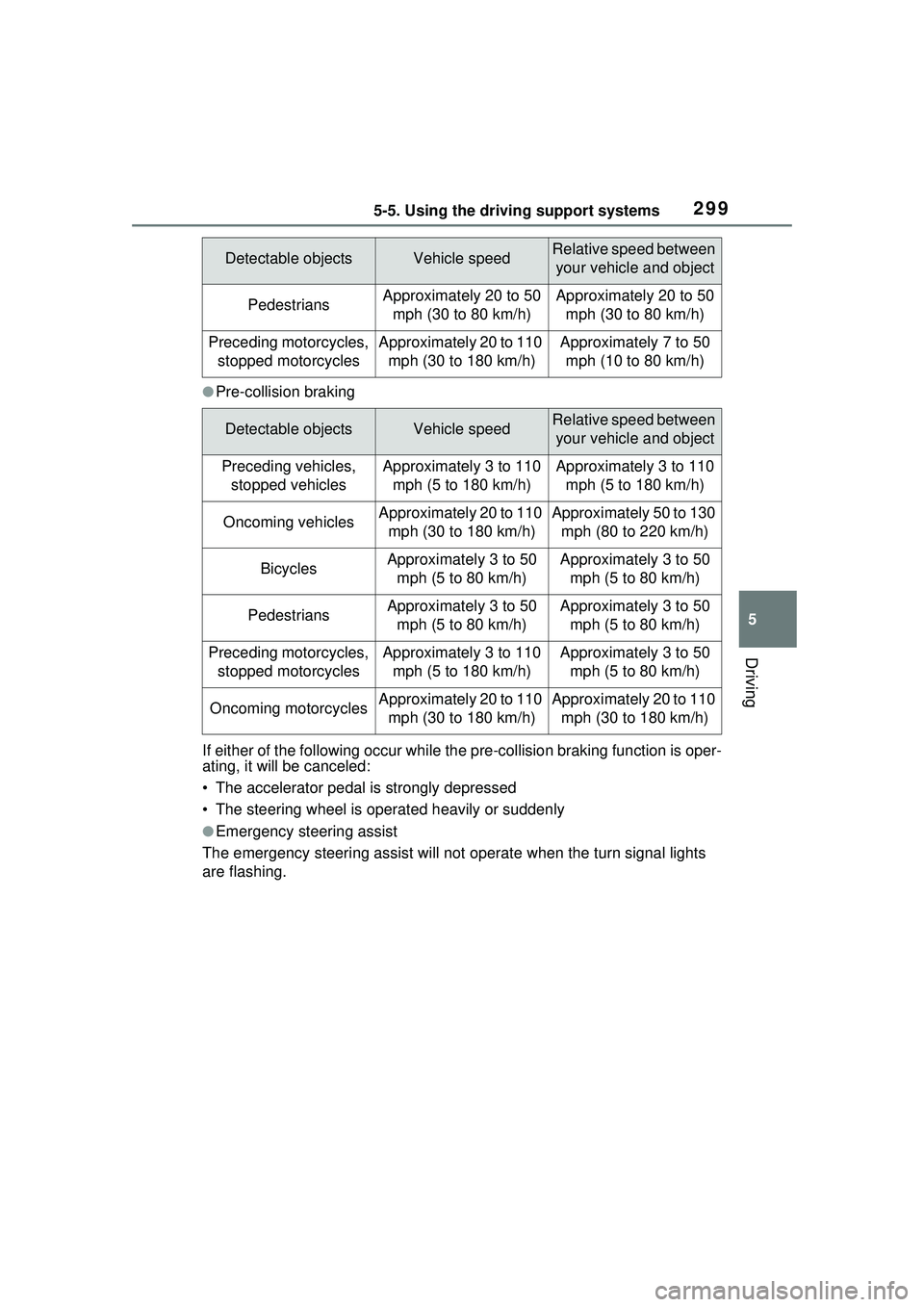
2995-5. Using the driving support systems
5
Driving
●Pre-collision braking
If either of the following occur while th e pre-collision braking function is oper-
ating, it will be canceled:
• The accelerator pedal is strongly depressed
• The steering wheel is operated heavily or suddenly
●Emergency steering assist
The emergency steering assist will not operate when the turn signal lights
are flashing.
PedestriansApproximately 20 to 50 mph (30 to 80 km/h)Approximately 20 to 50 mph (30 to 80 km/h)
Preceding motorcycles, stopped motorcyclesApproximately 20 to 110 mph (30 to 180 km/h)Approximately 7 to 50 mph (10 to 80 km/h)
Detectable objectsVehicle speedRelative speed between your vehicle and object
Preceding vehicles, stopped vehiclesApproximately 3 to 110 mph (5 to 180 km/h)Approximately 3 to 110 mph (5 to 180 km/h)
Oncoming vehiclesApproximately 20 to 110 mph (30 to 180 km/h)Approximately 50 to 130 mph (80 to 220 km/h)
BicyclesApproximately 3 to 50 mph (5 to 80 km/h)Approximately 3 to 50 mph (5 to 80 km/h)
PedestriansApproximately 3 to 50 mph (5 to 80 km/h)Approximately 3 to 50 mph (5 to 80 km/h)
Preceding motorcycles, stopped motorcyclesApproximately 3 to 110 mph (5 to 180 km/h)Approximately 3 to 50 mph (5 to 80 km/h)
Oncoming motorcyclesApproximately 20 to 110 mph (30 to 180 km/h)Approximately 20 to 110 mph (30 to 180 km/h)
Detectable objectsVehicle speedRelative speed between your vehicle and object
Page 300 of 680
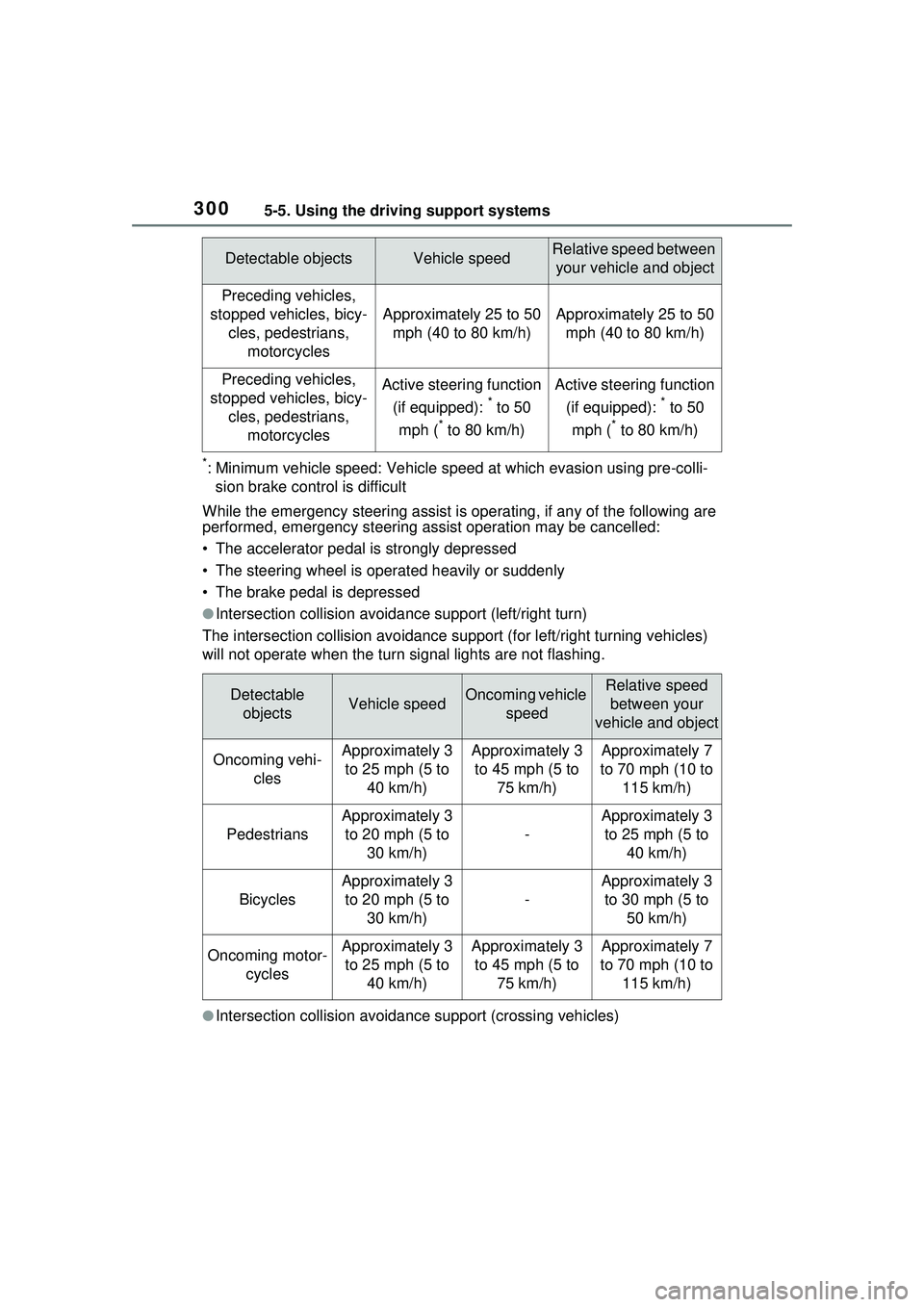
3005-5. Using the driving support systems
*: Minimum vehicle speed: Vehicle speed at which evasion using pre-colli-
sion brake control is difficult
While the emergency steering assist is operating, if any of the following are
performed, emergency steering assist operation may be cancelled:
• The accelerator pedal is strongly depressed
• The steering wheel is operated heavily or suddenly
• The brake pedal is depressed
●Intersection collisio n avoidance support (left/right turn)
The intersection collision av oidance support (for left/right turning vehicles)
will not operate when the turn signal lights are not flashing.
●Intersection collisio n avoidance support (crossing vehicles)
Detectable objectsVehicle speedRelative speed between
your vehicle and object
Preceding vehicles,
stopped vehicles, bicy- cles, pedestrians, motorcycles
Approximately 25 to 50 mph (40 to 80 km/h)Approximately 25 to 50 mph (40 to 80 km/h)
Preceding vehicles,
stopped vehicles, bicy- cles, pedestrians, motorcyclesActive steering function
(if equipped):
* to 50
mph (
* to 80 km/h)
Active steering function
(if equipped):
* to 50
mph (
* to 80 km/h)
Detectable objectsVehicle speedOncoming vehicle speedRelative speed between your
vehicle and object
Oncoming vehi- clesApproximately 3 to 25 mph (5 to 40 km/h)Approximately 3 to 45 mph (5 to 75 km/h)Approximately 7
to 70 mph (10 to 115 km/h)
Pedestrians
Approximately 3 to 20 mph (5 to 30 km/h)
-
Approximately 3 to 25 mph (5 to 40 km/h)
Bicycles
Approximately 3 to 20 mph (5 to 30 km/h)
-
Approximately 3 to 30 mph (5 to 50 km/h)
Oncoming motor- cyclesApproximately 3 to 25 mph (5 to 40 km/h)Approximately 3 to 45 mph (5 to 75 km/h)Approximately 7
to 70 mph (10 to 115 km/h)